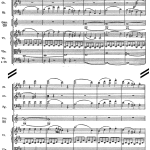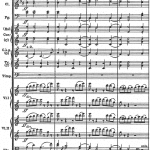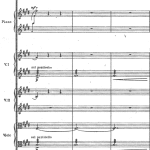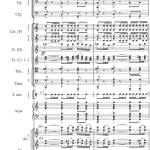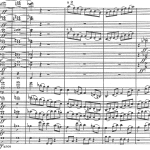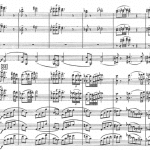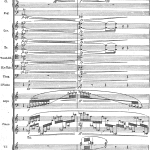At times, partial or simplified doublings may be used. A partial doubling motivated by practical concerns frequently occurs when two instruments that do not share the same level of agility, for instance cellos and basses, are doubled. Here the basses will often play a simpler version of the cello part, taking into account the idiomatic characteristics and technical capabilities of the individual instruments.
Figure 51 · Mozart, The Marriage of Figaro, Overture, m. 112
The bassoon and flute double the melody in the 1st violins, but with tiny modifications that prevent embellishments or pitches in a high or somewhat strained register from threatening the elegance of the melody.
The following violin passage from Berlioz’ Symphonie fantastique is a quasi-heterophonic partial doubling of the main theme presented in flutes, cornets and violas. At the same time, the passage demonstrates how orchestration can contribute to simplifying technical instrumental issues: large intervals in a high register and at a rapid tempo can easily cause intonation problems and are largely avoided here by distributing the theme among the violins. It should be noted that the division of a string group into two equal parts in general does not noticeably influence the volume of each half, but can reduce the density of sound to a certain degree (cf. Dynamics and Balance).
Figure 52 · Berlioz, Symphonie fantastique, 1st movement, m. 413
The following example shows that the distribution between two instruments can help to facilitate an otherwise rather difficult double-tonguing passage, particularly at a fast tempo such as this.
Figure 53 · De Falla, Nights in the Gardens of Spain, number 7
In Ravel’s Bolero,oboes and clarinets take part in the persistent bolero rhythm. But while the horns realize the fast triplets without difficulty, the “triple-tonguing” is modified for purely practical reasons in the two groups of woodwinds.
Figure 54, Ravel, Bolero, m. 293
Partial doubling can take many different forms. In the example below, 1st violins and cellos partly double the 2nd violins and violas while the cellos change register. The double basses partly double the 1st violins in contrary motion.
Figure 55 · Berlioz, Symphonie fantastique, 1st movement, number 6, m. 3
In the following example, the woodwinds partly double the high strings, while the horns partly double the lower strings. Complete doubling would result in a heavy and massive sound.
Figure 56 · Bartók, Concerto for Orchestra, 1st movement, number 51
Heterophony is a term frequently associated with oriental music. The term goes all the way back to Plato’s music theory, where it describes a melody sung by a choir while a soloist embellishes the same melody with – usually improvised – ornaments, grace notes, etc. In symphonic Western music, heterophony (or textures resembling heterophony) generally occurs as a special effect, for instance in the form of several simultaneous versions of the same melody, but it may also function as an extended doubling strategy. In the case of a pioneer like Berlioz, and not least in the music of the 20th century, such creatively motivated and widely different heterophony-like doublings have been of great importance for the development of the orchestra as a medium. Textures of this kind are often motivated by compositional issues rather than matters of orchestration, which is why the expression heterophony is used here as a collective term to denote these special types of doubling strategies (cf. figure 24). Judging whether a passage involves partial doubling or leans more towards heterophony is a matter of opinion, of course. As mentioned previously, the conceptual system applied here does not attempt to establish rigid classifications, but to identify phenomena that reveal clear similarities and occur with a certain frequency in various guises.
A special and frequently occurring texture in the grey zone of doubling schemes is the use of rapidly ascending or descending lines, scales or passages in the most agile instruments (notably strings, flute, clarinet, piano/harp, etc.) to underscore an overall directional movement or gesture. In such cases, comprehensive doubling would sound unnecessarily weighty or overly defined, which is why the design of such gestures varies greatly from one instrument to another. Their function is often similar to that of doubling, but neither heterophony nor partial doubling seem to be fitting descriptions. Perhaps one could speak of “orchestrated gesture.” The following is one of countless examples in the orchestral literature.
Figure 57 · De Falla, Nights in the Gardens of Spain, number 15, m. 3
Orchestrated accents, crescendos, diminuendos, etc., are dealt with elsewhere in this book, but certainly these and similar techniques can technically be considered examples of partial doubling.
· · ·
Next · Reverberation, Echo, Resonance and Acoustic Reflection (Chapter 4. Unisono and Doubling)
